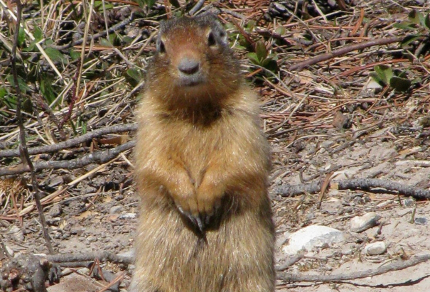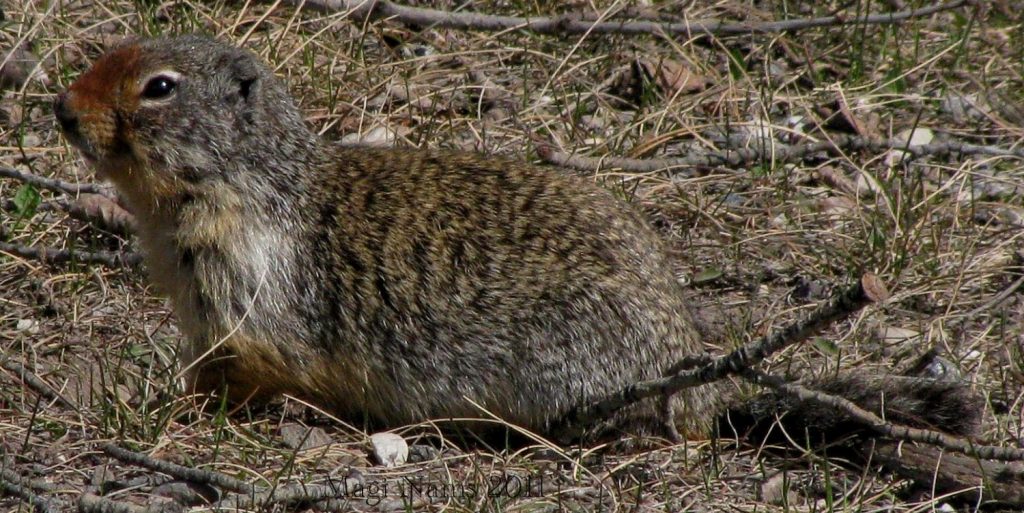Perky and agile, the Columbian ground squirrel lives in colonies, inhabits alpine clearings, and hibernates for more than half the year.
May’s mammal of the month is the Columbian ground squirrel, Urocitellus columbianus. It’s a medium-sized member of the rodent family Sciuridae, which includes tree-dwelling squirrels, ground-dwelling squirrels, marmots and chipmunks. This ground squirrel has a dense, flecked pelage and a distinctive reddish-brown patch of fur on its face, above its nose.
The Columbian ground squirrel occurs in North America’s central Rocky Mountains, from southern Alberta and British Columbia to Washington, Oregon, Idaho and Montana. It can be found at elevations of 210 to 2410 metres and inhabits south-facing alpine meadows, forest clearings, grasslands, sagebrush plains and agricultural fields and pastures. It requires light, sandy soil for burrowing and lives in colonies.1

Columbian Ground Squirrel (Urocitellus columbianus) at Burrow in Banff National Park, Alberta, Canada (©Magi Nams)
I spotted my first Columbian ground squirrel while hiking on the outskirts of Banff, Alberta, in the Canadian Rockies. I soon noticed others soaking up spring sunshine outside their burrows dug into a sandy, gravelly esker overlooking the scenic Bow River. The ground squirrels kept a wary eye on me as I hiked past. Some stood at attention. Others emitted a warning whistle and dashed into their burrows.

Columbian Ground Squirrel (Urocitellus columbianus) Standing at Attention, Banff National Park, Alberta, Canada (©Magi Nams)
Columbian ground squirrels are larger and chunkier than the Richardson’s ground squirrels familiar to me from growing up on an Alberta farm. Their total length is 32-38 centimetres. Their weight ranges from 300-800 grams and varies widely during the year, since these ground squirrels hibernate. When they enter hibernation in late summer, they’re fat. When they return to above-ground activity in early spring, they’re emaciated. Males emerge from hibernation earlier than females and feed on seeds stored in their burrows until other foods are available.2
Columbian ground squirrels are primarily herbivorous. They feed on leaves and flowers, bulbs, roots, stems, berries and seeds of a variety of plants, including farmers’ crops. They have also been known to dine on insects, dead fish and mice.1
Colonies of Columbian ground squirrels consist of groups of females plus breeding males and non-breeding male offspring that haven’t yet dispersed. Female offspring tend to remain near their home nest. Male offspring disperse during their second summer. Both male and female Columbian ground squirrels fight for dominance. The males fight other males to obtain and defend territories that overlap those of several females.2 Females fight non-kin females to defend feeding territories.3 In the world of ground squirrel aggression, it’s a case of “bigger is better,” since larger ground squirrels are more likely to win fights.2
References:
- Cassola, F. 2016. Urocitellus columbianus. The IUCN Red List of Threatened Species 2016: e.T42466A22265632. Accessed on May 3, 2017 at http://dx.doi.org/10.2305/IUCN.UK.2016-3.RLTS.T42466A22265632.en.
- Forsyth, Adrian. 1985. Mammals of the Canadian Wild. Camden House Publishing, Camden East, ON. pp. 198-199.
- Vincent A. Viblanc, Cristian Pasquaretta, Cédric Sueur, Rudy Boonstra, F. Stephen Dobson. 2016. Aggression in Columbian ground squirrels: relationships with age, kinship, energy allocation, and fitness. Behavioral Ecology 27 (6): 1716-1725. Accessed on May 16, 2017 at https://academic.oup.com/beheco/article-abstract/27/6/1716/2453475/Aggression-in-Columbian-ground-squirrels?rss=1.



